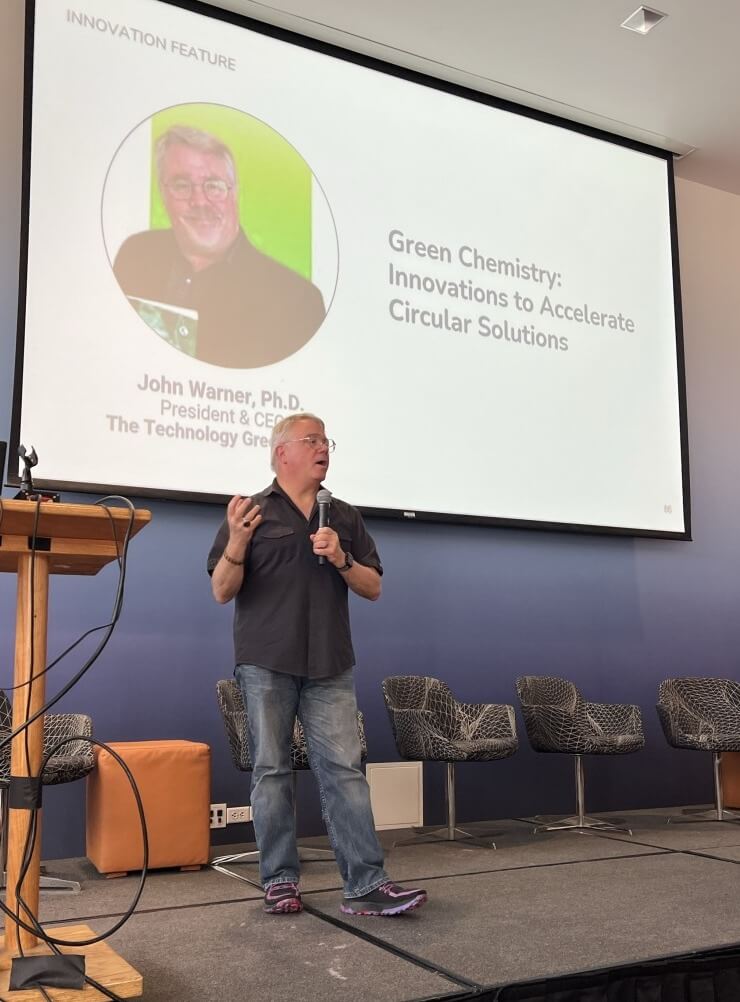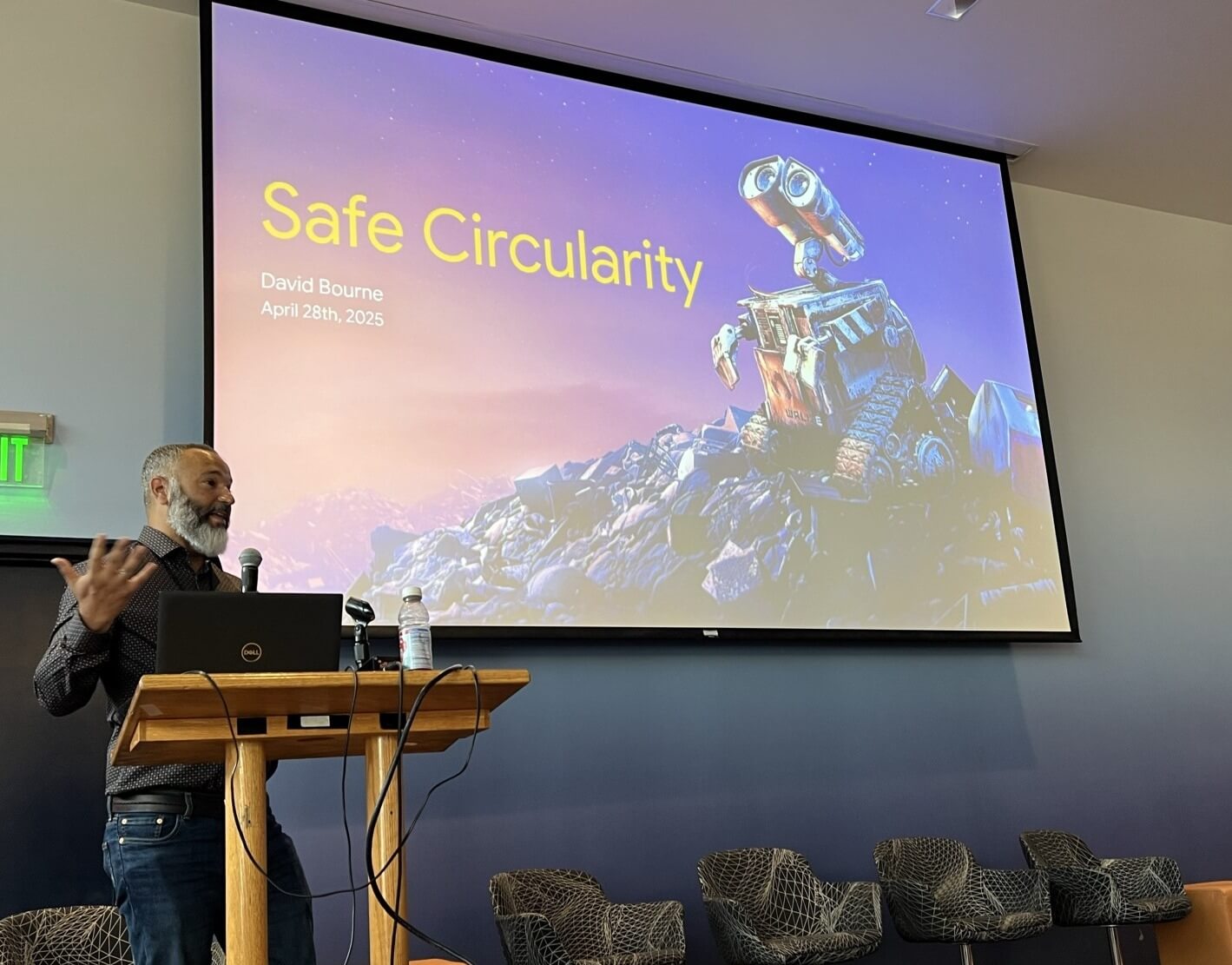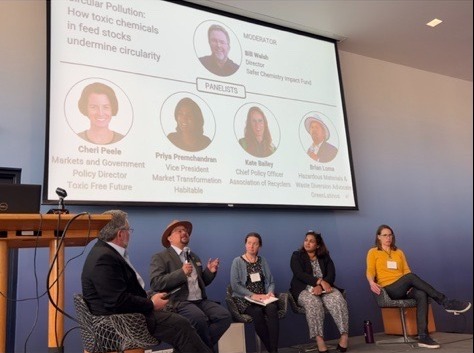Creating a Safe and Circular Future with Sustainable Chemistry
In April, more than 1,100 leaders across industries and value chains convened to advance solutions for the circular economy at Circularity 2025 hosted by Trellis Group. The day before this premier event, Change Chemistry, ChemFORWARD, and the Safer Chemistry Impact Fund jointly hosted the From Circular Pollution to Circular Solutions workshop to highlight the critical role safer and more sustainable chemistry play in a circular economy.

A circular economy moves from a linear, make-take-waste model to a closed loop model that designs out waste through product and material maintenance, reuse, refurbishment, recycling and composting. This system is inherently regenerative and can lead to reduced carbon emissions, improved human and ecosystem health, economic growth, and enhanced business resilience.
With these possibilities in mind, there was undeniable energy during Circularity week as attendees dove into the central question posed expertly by Jon Smieja, VP of Circularity at Trellis Group, during Monday’s Workshop: How do we make circularity at the core of what people do?
John Warner, Co-Founder of green chemistry and President & CEO of The Technology Greenhouse, leveled that we must start at the beginning. Many of the solutions that will enable a circular economy, as well as safer and more sustainable materials, haven’t been invented yet. And to develop these innovations, we must think differently.
 Chemistry is the key tool that will enable products and materials to have enhanced durability, recyclability, and amenability to remanufacturing, meaning chemistry and circularity are intrinsically linked. However, this connection may be overlooked, and in those cases, progress is stunted. Incorporating green chemistry, toxicology, systems thinking, and business in chemistry curriculum is needed for chemists to develop the necessary skills and thinking to create circular innovations.
Chemistry is the key tool that will enable products and materials to have enhanced durability, recyclability, and amenability to remanufacturing, meaning chemistry and circularity are intrinsically linked. However, this connection may be overlooked, and in those cases, progress is stunted. Incorporating green chemistry, toxicology, systems thinking, and business in chemistry curriculum is needed for chemists to develop the necessary skills and thinking to create circular innovations.
Take, for instance, plastic packaging, which is responsible for 36% of all plastic produced globally. Recycling is an important end-of-life tool, but the different monomers and the addition of various additives make recycling challenging. In fact, only 9% of plastic waste is recycled globally. Transitioning to circular packaging will require more robust recycling techniques and infrastructure, but perhaps more importantly, it also requires designing for circularity.
Jill Martin, Global Sustainability Fellow at Dow, highlighted how feedstocks, additives, and material traceability directly impact end of life outcomes. Considering these attributes during the design, manufacturing, and use phases will close the material ecosystem loop by feeding waste back in as a value-added input. Developing biobased and biodegradable materials creates an outer loop that, if managed properly, attributes to nature regeneration and biodiversity. There are several innovators already leveraging this concept that shared their work during Circularity week, including Sway, Aruna Revolution, and RENW to name a few.
Another key, but often overlooked, component of designing for circularity is knowledge of chemical hazards. In a circular economy, the use of hazardous chemicals will simply create circular, hazardous pollution. Thus, to protect consumer health and ensure valuable feedstocks for recirculation, chemicals must be proactively and systematically characterized for hazards. Uknown hazards present risk for the entire supply chain, and chemical hazard assessments enable the identification and verification of safer chemistry as well as the identification of additional, non-regulated hazardous chemicals that should be eliminated.
This was the focus of the From Circular Pollution to Circular solution workshop, but the transition won’t be easy. David Borne, Lead Sustainability Strategist at Google, offered that it may be more difficult than tackling climate change. While the most potent greenhouse gases can be clearly identified and focused on, there is a large number of chemicals that are uncharacterized for human and environmental health and need comprehensive chemical hazard assessments.

However, David also outlined a roadmap for the path forward and hopeful progress - by aligning goals, collaborating, and increasing data transparency across sectors and industry verticals, the challenge is proving manageable. Stacy Glass, Co-Founder & Executive Director of ChemFORWARD, seamlessly demonstrated this while sharing the results from their recent Beauty and Personal Care Ingredients Intelligence Report, a product of the Know Better Do Better Collaborative. After analyzing over 8,500 products submitted by companies, they found a striking fact: although there were ~318,000 ingredients listed, there were only 2,279 unique ingredients and ~70% were already characterized with 66% representing verified safer chemistry. By working collaboratively, the cost to fill each data gap is only $6, and the number of unknowns becomes significantly less daunting.
This type of collaboration and sector-by-sector focus enables a targeted approach to eliminating the chemicals of greatest concern and developing alternatives. To continue driving change, the support of and collaboration with regulators, investors, and communities is also essential. Regulators create powerful demand signals and incentives to support strategic chemicals management. Investors provide the funds necessary to systematically replace chemicals of concern with verified safer alternatives. Bill Walsh, the Founder of the Safer Chemistry Impact Fund, demonstrated this by outlining how the organization mobilizes global investment and impactful initiatives by collaborating with leaders. For example, Renee Hackenmiller-Paradis of Lululemon announced a SCI Fund Apparel Working Group comprised of Lululemon, Patagonia, and Nike.
 As underscored by Brian Loma, Hazardous Materials and Waste Diversion Advocate at GreenLations, local communities play a critical role in sustainability efforts as well. Communities that face the brunt of chemical and material pollution have invaluable knowledge that must be incorporated into our decision-making schemes and solutions development.
As underscored by Brian Loma, Hazardous Materials and Waste Diversion Advocate at GreenLations, local communities play a critical role in sustainability efforts as well. Communities that face the brunt of chemical and material pollution have invaluable knowledge that must be incorporated into our decision-making schemes and solutions development.
Achieving a true circular economy will require everyone to come to the table. At Change Chemistry, we convene the full chemical value chain, policymakers, and non-profits to collaboratively share best practices, breakdown barriers to safer and more sustainable chemistry, and accelerate the adoption of innovative solutions. Our partnerships – like those with ChemForward and Safer Chemistry Impact Fund - are crucial to this work. By leading this transition, our efforts drive towards a safe and circular future.
